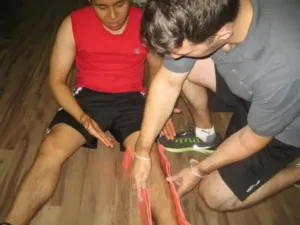On this page we will address some popular CPR related questions that Canadians may have. The questions are as follows:
- How do you adapt CPR for someone who is choking or has a blocked airway?
- What should you do if you are alone and need to perform CPR?
As first aid instructor trainers, program developers and liaisons with provincial regulator body’s we will help answer these questions and encourage you to get certified with a reputable provider in CPR and AED training.
How do you Adapt CPR for Someone Who is Choking or Has a Blocked Airway?
Cardiopulmonary resuscitation involves chest compressions and ventilations. If the airway is fully obstructed then attempting to ventilate will not be successful. The rescuer needs to focus on addressing the blockage prior to doing regular CPR. If the victim is conscious then the rescuer should, with permission, attempt 5 back blows followed by 5 j-thrusts until the object is removed or until the victim is no longer conscious. If the victim is unconscious, with a known obstruction, the rescuer should check the mouth after every set of compressions to see if the obstruction is visible and then remove it.
It’s one thing for me to explain this in writing but learning the skill in person is the most effective method to learning CPR for an obstructed airway. This is why it’s so important to get certified and trained by a reputable CPR and AED course provider.
What should you do if you are alone and need to perform CPR?
If you’re alone and someone needs CPR then you have a few options to successfully be part of the chain of survival:
- Take out your cell phone and contact EMS and they will provide the assistance you need
- If you do not have a cell phone grab a land line and immediately contact EMS. Place the phone on speaker and attempt to continue providing aid while on the phone
- If you do not have a cell phone or land line yell into a public area or go outside and shout for help so that someone can contact EMS for you. Ensure that you use your skills learned in CPR class when addressing someone to contact EMS.
- If you do not have anyone nearby, are not in a public space, do not have a phone or reception, attempt to do you best CPR while yelling for help. If nobody can hear you after several attempts then run to your nearest cell phone reception area or area where someone can contact EMS before start CPR.
Learn more about how to manage CPR in difficult situations by enrolling in CPR training in Grande Prairie with a reputable provider.
Did You Know? Get A Head Start on Your First Aid Training by Learning About Fractures
Fractures

A fracture happens when an outside force causes a break in the bone. The break can be a complete break (a through and through break) or a partial break that causes a portion of the bone to break. When a victim experiences a fracture or falls and a fracture is suspected:
- Stabilize the affected area.
- Check to see if the victim is unresponsive.
- If unresponsive, call your local emergency number and perform cardiopulmonary resuscitation (CPR) immediately.
- If victim is responsive, stabilize the affected area and bring victim to the nearest emergency room.
